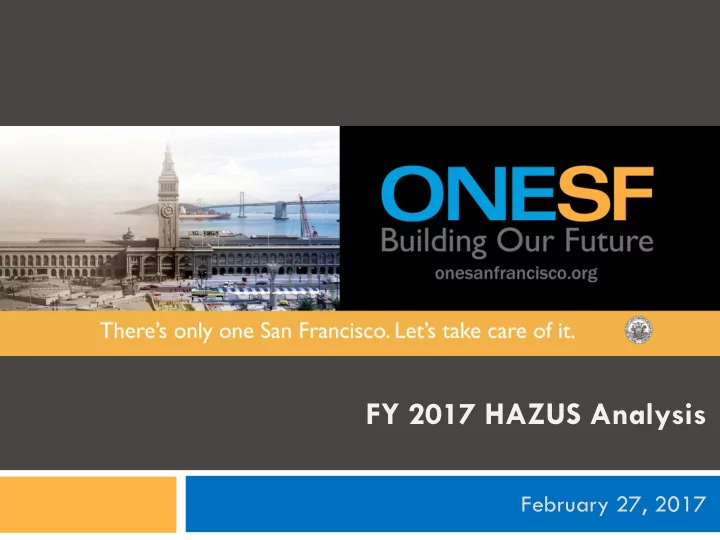

FY 2017 HAZUS Analysis February 27, 2017
HAZUS Overview 2 HAZUS is a nationally-applicable methodology developed by FEMA to estimate potential losses from earthquakes, hurricanes, and floods Input: Soil maps, ground shaking maps, building inventory maps, building structural data, building occupancy data, building economic data Output: Estimated economic impact, building damage, and casualties It is a relative risk model, and helps prioritize mitigation efforts, emergency preparedness, and response and recovery planning MITIGATION EMERGENCY PREPAREDNESS RESPONSE & RECOVERY • Prioritize seismic retrofits of • Create scenarios for use in • Assess the need for post- existing facilities developing emergency disaster damage assessment • Support development of local response plans (e.g., • Support response planning hazard mitigation plans temporary housing, debris for critical transportation • Support development of removal, etc.) and for outages hazard-resistant building emergency response exercises • Recovery planning codes & land use planning activities
HAZUS Recap of previous analyses in San Francisco 3 HAZUS for earthquakes in San Francisco was first conducted in 2012 The initial run included 82 high-priority buildings High-priority buildings included emergency response facilities, emergency shelter locations, primary department operation centers (DOCs), and vulnerable buildings The analysis has been updated twice since then, with the last run in 2013 The last run included 214 high-priority buildings In each analysis, four earthquake scenarios were modeled to estimate the impact on each building Significant driving factors affecting potential losses include building design level, building occupancy, building exposure value, and liquefaction potential
HAZUS Uses 4 Improved capital planning Better understand where further seismic analysis is needed Prioritize seismic-related capital projects Offer a consistent planning framework going forward Examples of vulnerable buildings identified by previous HAZUS analyses include: Veteran’s Building (recently-completed retrofit) Animal Care and Control facility (replacement facility is in design) 101 Grove (relocation of staff is in planning) Hall of Justice (some depts. relocated, complete exit is in planning) Guidance for important emergency response planning decisions Inform emergency response actions plans, and locations of Emergency Operating Centers E.g. seismically sound facilities with high peak occupancy (e.g. Moscone Center) may not need structural work, but do need a robust emergency response plan Improves eligibility for federal grants or FEMA reimbursement, and identified as action 3.I in the City’s 2014 Hazard Mitigation Plan
HAZUS Prioritization Process 5 City-owned Portfolio ANALYSIS Hazus Analysis: High-Priority Buildings SHR SHR SHR CAPITAL PROGRAMS Bond Programs Other Sources B.O.R.P Program
HAZUS FY 2017 Analysis 6 Recently completed an update of the HAZUS analysis, in conjunction with Public Works and Rutherford + Chekene Analysis was expanded to include 239 facilities Structural information for all buildings was further vetted by Public Works Occupancy and content value assumptions were updated by departments
HAZUS FY 2017 Analysis 7 LIQUEFACTION SUSCEPTIBILITY
HAZUS FY 2017 Analysis 8 GROUND SHAKING MAPS San Andreas M7.9 San Andreas M7.2 San Andreas M6.5 Hayward M6.9
HAZUS FY 2017 Results (1/3) 9 PROJECTED ECONOMIC IMPACT (LOSSES) Hayward San Andreas San Andreas San Andreas M6.9 M6.5 M7.2 M7.9 $ in millions Structural Damage 107.2 133.4 212.3 353.1 Non-Structural Damage 398.3 545.4 859.7 1,489.3 Total Building Damage 505.5 678.8 1,072.0 1,842.4 Content Damage 130.1 426.7 523.6 714.3 Operational Losses; Rent, 154.8 191.9 314.7 527.2 Relocation & Lost Income Total Economic Impact 790.4 1,297.3 1,910.3 3,083.8
HAZUS FY 2017 Results (2/3) 10 PROJECTED BUILDING DAMAGE Hayward San Andreas San Andreas San Andreas M6.9 M6.5 M7.2 M7.9 Green-tagged 195 183 127 75 Yellow-tagged 32 44 89 74 Red-tagged 12 12 23 90 Total Buildings 239 239 239 239
HAZUS FY 2017 Results (3/3) 11 POSSIBLE RED-TAGGED BUILDINGS WITH >70% DAMAGE (SAN ANDREAS M7.9) Animal Care and Control Facility – Mothers Building replacement facility in design Municipal Railway Overhead Lines – will be DPH Central Office (101 Grove) – replaced by new ACC facility relocation of staff planned Park Police Station – being considered for 9 Fire Stations – 3 will be addressed under ESER Program ESER Program, others need further study Park Senior Center Fire Chief's Residence Produce Market Hall of Justice – some depts. already REC Corporate Yard Buildings relocated, complete exit in planning SFFD Equipment Unit Headquarters – being Hunters Point Art Studios considered for ESER Program Kezar Pavilion – study underway Tom Waddell Clinic – relocation planned Maxine Hall Health Center – renovation underway McLaren Lodge
Seismic Hazard Rating Categories 12 SHR Description SHR-1 Minor damage (good performance). Some structural or nonstructural damage and/or falling hazards may occur, but these would pose minimal life hazards to occupants. The damage can be repaired while the building is occupied and with minimum disruptions to functions. SHR-2 Moderate damage (fair performance). Structural and nonstructural damage and/or falling hazards are anticipated which would pose low life hazards to occupants. The damage can be repaired while the building is occupied. SHR-3 Major damage (poor performance). Structural and nonstructural damage are anticipated which would pose appreciable life hazards to occupants. The building has to be vacated during repairs, or possibly cannot be repaired due to the extent and/or economic considerations. SHR-4 Partial/total collapse (very poor performance). Extensive structural and nonstructural damage, potential structural collapse and/or falling hazards are anticipated which would pose high life hazards to occupants. There is a good likelihood that damage repairs would not be feasible.
Seismic Hazard Ratings Results for select City buildings 13
Building Occupancy Resumption Program (BORP) 14 Expedited post-disaster building inspection and occupancy determinations 156 private and 8 public buildings are participating in the program In addition, 22 facilities are part of the Port’s BORP program
Questions & Comments 15 onesanfrancisco.org Brian Strong, CRO 554-5165 Heather Green, Assistant Director 554-5162 Nishad Joshi, Administrative Analyst 554-5164 Joshua Low, Administrative Analyst 554-5166 Hemiar Alburati, Business Applications Manager 554-5161 Tom Cassaro, SF Fellow 554-6075
Recommend
More recommend